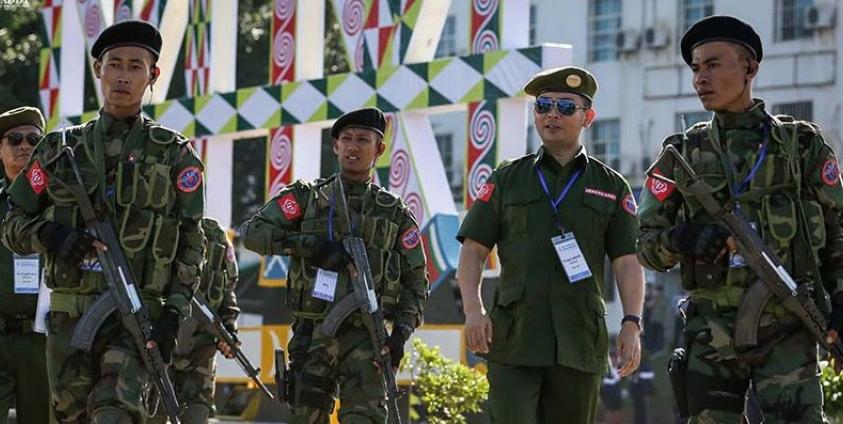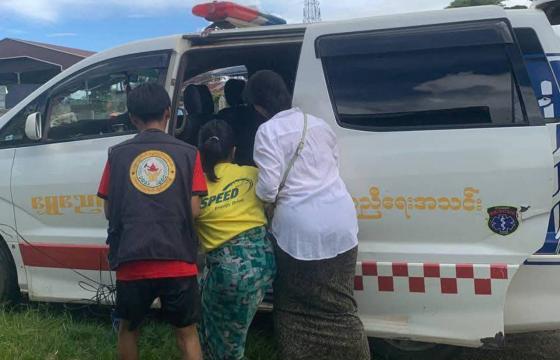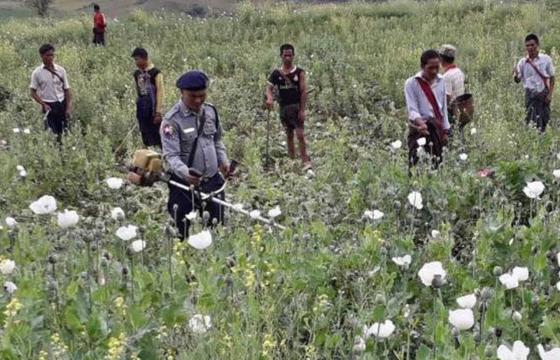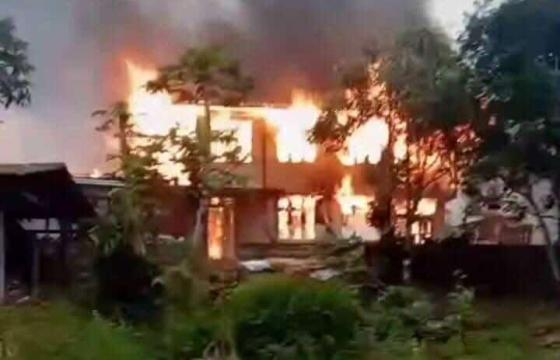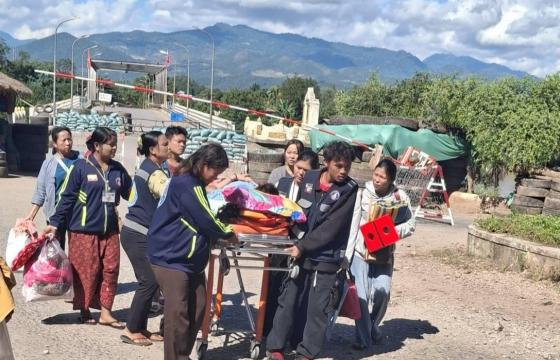The January 4 deadly early morning raids of the four police outposts by the Arakan Army (AA) that inflicted heavy causality to the police forces, coinciding with the 71st Burma or Myanmar independence day, is a stark reminder that civil war is still an everyday reality in the country, even though the Tatmadaw or Military has readily doled out a partial unilateral ceasefire in five military commands on December 21 to revamp the peace process that has stalled since a few months ago.
Reportedly, Brigadier General Zaw Min Tun from the information department of the Office of the Commander-in-Chief confirmed that the AA attacked four police outposts the Kyaung Taung, Kahtee Hla, Gotepi, and Nga Myin Taw in Buthidaung township, killing the 13 men and wounding 9.
The AA attacked the four police outposts using some 350 men on Friday January 4 around 6 am. The Tatmadaw retaliated which also included two helicopter gunships at about 8 am and around 9 am the AA withdrew, according to the press release of government’s information department.
Ten policemen from the Nga Myin Taw station, two from the Kahtee Hla station, and one from the Kyaung Taung station were killed, he said.
The raids accordingly have no connection with the independence anniversary occasion, said Khaing Thu Kha the AA spokesman.
“We are not independent yet. Today is not our Independence Day,” he stressed when pressed on with the speculation.
But arguably the timing could also have been calculated to drive home the message with maximum effect regarding the Arakanese people’s struggle for the rights of self-determination.
Another point might be purely an act of self-defense, as the Tatmadaw’s partial unilateral ceasefire excluded the Western military command that covers the Chin and Arakan States, where the AA is operating and taking cues from the Tatmadaw’s military offensives on its troops starting last November, it naturally concluded the ceasefire in other military commands is to concentrate in wiping out its organization from the said areas.
For the Tatmadaw’s part it is determined not to let the AA have its footholds in Chin and Arakan States, while the latter is also fully committed to have its bases established among its people primarily in Arakan State.
The making of AA
Arakan Army (AA) is a newly formed organization which comes into being only ten years ago.
It was founded on 10 April 2009 and the AA is the main military wing of the United League of Arakan (ULA) and prided itself to be the only revolutionary Army for people of Arakan or Rakhine and its fatherland.
It was originally trained in Kachin State, Kachin Independence Army (KIA) Military Academy and has gathered combat experiences while fighting along side with Northern Alliance-Burma (NA-B), which it is also a member that includes KIA, Myanmar National Democratic Alliance Army (MNDAA) and Ta’ang National Liberation Army (TNLA), in Shan and Kachin States. The AA also have additional training camps now in Arakan State.
It is estimated to be some 7000 strong as reported by The Irrawaddy in its January 8, 2019 analysis. According to Myanmar Peace Monitor the AA was said to be 1,500 strong in 2014 including personnel stationed in Arakan State near Myanmar’s Bangladesh border and The Irrawaddy stated that it has 2,500 troops and 10,000 supporters as of September 2015.
The ideology of AA is based on what it described as “The Rakhita Way”.
The Rakhita Way main objectives observed by the Arakan Army, according to the ULA/AA website, are:
- To struggle for the rights of self-determination for people of Arakan who are now subjected to alien subjugation, domination and exploitation under the Burman colonial rule
- To provide the safeguarding and promotion of the national identity and cultural heritage of the people of Arakan and
- To serve the “national dignity” and best interests of the people of Arakan.
The AA considered Arakan to have been an independent nation for thousands of years since 3000 BC which had fallen under colonization, due to Bamar monarch Boedaw U Wine and his militants invasion in 1784. It rejected the Burman colonial domination and occupation and is exercising “the right of national self-determination to protect the fatherland of Arakan and its people,” according to its website.
It further emphasized the need to realize Arakan dream as: “Under the Burman colonial rule and racist regime, Arakan has now become the poorest state of Myanmar where people of Arakan are falling into the vicious cycle of inequality, poverty and famine. These great sufferings and tragedies have given the Arakanese new generations no choice but to launch national revolution.”
AA intensifies its military moves
Starting 2014 the AA penetrated into Arakan State and by 2018 have been able to expand its operational areas to include Maungdaw, Buthidaung, Rathedaung, Mrauk U, Ponnagyun and Kyauktaw Townships, also including Paletwa Township in Chin State.
The AA has been fighting along side the KIA since the 17 years ceasefire broke down in 2011 and actively involved in February 2015 Kokang conflict, when the MNDAA tried to wrestle back its territory from the military-backed local government, together with the NA-B against the Tatmadaw, where hundreds Tatmadaw troops were reportedly killed.
The military confrontation with the Tatmadaw in Chin and Arakan States steadily increased from year to year starting 2015 and the 2018 saw more fierce battles and topping it with the latest new year clashes, which killed 13 policemen and wounded 9 others. In the recent clashes, which the AA overran the four police outposts, 18 were taken in as prisoners of war, according to the AA spokesman Khaing Thu Kha. However, they were released the following evening.
“We have released them this evening. 1 immigration personnel, 4 women and more than 10 police troops, all were securely set free without danger,” said Khaing Thu Kha.
Regarding the release of the arrested prisoners he added: “We never give trouble to enemies that surrender for we do things according to the agreement of Geneva Convention.”
Starting November 30, 2018, AA and Tatmadaw have fought each other in Buthidaung, Rathedaung, Kyauk Taw Townships and the military engagements have continued daily until January 4, 2019, increasing the Internally Displaced Persons (IDPs) population each day. According to local relief groups, internally displaced persons (IDPs) in the region now number about 4,500, although the actual figure could be even higher, as some of the displaced villagers are not sheltering in designated IDP camps.
Following the AA’s January 4 raid on police outposts in Buthidaung Tatmadaw sent in reinforcement and battles have been going on, according to the AA spokesman.
“Battles haven’t stopped yet, they are continuing with the Bamar Army pounding (us) with heavy artillery. They are firing heavy guns in the whole area and also bombarding using helicopter gunships. For example, Kahtee Hla village populated by Mro people who are Rakhine sub-ethnic group was all burned down,” said the AA spokesman.
He added: “Four Townships Buthidaung, Rathedaung, Ponnakyun and Kyauk Taw are now the main battle areas and they (Tatmadaw) are reinforcing massively. Especially in Rathedaung and
Buthidaung they are launching offensives on us.”
Reportedly, heavy fighting are raging between the AA and Tatmadaw in the said areas.
Meanwhile, Myanmar government spokesman Zaw Htay in a news conference in Naypyitaw on January 7 said that State Counselor Aung San Suu Kyi, President Win Myint and other cabinet members met military leaders, including Tatmadaw chief Min Aung Hlaing, his deputy and the military intelligence chief, to discuss “foreign affairs and national security”.
Accordingly, he said that the president’s office has instructed the military to launch an operation to crush the terrorists.
He especially pointed out: “On July 23, we received news that AA and Arakan Rohingya Salvation Army (ARSA) held a meeting in at Rabul in Bangladesh. One possibility is demarcation of territories. western part of Maungdaw, Buthidaung, Rathedaung, in general Mayu mountain range will be ARSA operational area; and the eastern part of it will be AA operational area, according to a (government) source.”
He added: “Another source said that AA and ARSA have common economic cooperation and that is drugs trafficking. ARSA will be given Mayu District and the rest will be Arakan country. A source said that the AA will create Arakan Republic.”
The next day, AA spokesman Khaing Thu Kha denied all of Zaw Htay’s allegations and said that they are merely political dirty tricks.
In the same vein, a Bangladeshi foreign ministry official and two Border Guards Bangladesh (BGB) officers denied the accusation of Zaw Htay in his news conference that Bangladesh is harboring 2 AA and 3 ARSA military camps within their country. One BGB officer asked Myanmar to provide evidence of militant camps in Bangladesh.
Different reasons
The blame for the AA attacking the four police outpost could be detected when the Tatmadaw spokesman Brig-Gen. Zaw Min Tun said that they are located in the ethnic Arakanese villages of Kyaung Taung, Nga Myin Taw, Ka Htee La and Kone Myint in northern Buthidaung Township and the on-duty officers are there to defend and provide security for the villages.
“Na Ta La” villages, as they are known, refers to the Development of Border Areas and National Races, a village project set up in the early 1990s under the regime of former General Than Shwe.
“Such attacks on small outposts are really bad, because they are there mainly to ensure the safety of ethnic villagers,” said the Tatmadaw spokesman General Zaw Min Tun, possibly indicating that AA is against the public interest.
But the AA spokesman Khaing Thu Kha earlier told the media that the Tatmadaw had brought ordinary and Border Police units into active conflict zones as part of its “Four Cuts” counter insurgency strategy, the policy was developed in the 1970s during the regime of the Burmese Socialist Programme Party with the intention to cut off access to food, funds, information and recruitment for the ethnic resistance armies.
The AA spokesman outlined three reasons for the AA attack on the four outposts. One is that the Tatmadaw has been using the Border Police in helping the military to conduct heavy artillery attacks at the front in northern Rakhine against the AA.
Another is in process of the Tatmadaw’s “Four Cuts” strategy, the police have been torturing the villagers in Buthidaung and Rathedaung Townships. And to make clear that the AA meant business, it sent letters together with a bullet each to three persons in Buthidaung Township, which included a police station chief, a village administrator, and a prominent timber businessman, warning them not to obstruct the its organization’s activities.
And finally, he said: “Another thing is during these few days the Tatmadaw is using excessive military strength in conducting the offensives against the AA. That is why we have to attack the police border outposts.”
The Tatmadaw top brass denied that there is a military command present in the conflict zone in Buthidaung, but some local residents confirmed that Light Infantry Unit 552 is currently deployed there. The unit is under the Taung Bazar-based No. 15 military command, according to the The Irrawaddy recent report.
Graduation ceremony at Wunlet Post (Arakan Army)Graduation ceremony at Wunlet Post (Arakan Army)
AA position on Rohingya
While observers and experts alike are worried that the AA and Tatmadaw engaging in fierce armed conflict, which is a new dimension different from the Rohingya issue, could destabilize and escalate the western region, particularly the Arakan State, to an extend becoming similar to Syrian conflict as China, India, Bangladesh, Myanmar are all involved, the implication of the two conflict issues is not without connection.
In this respect, what the AA might has in store regarding the Rohingya conflict, which is already a controversial international issue, needs to be explored.
In December 2017, AA leader Tun Myat Naing called on the Arakanese people not to let their emotions lead them to become involved in the conflict in Rahkine State, Rohingya issue. A video released depicted the issue as a “political trap” on AA’s Facebook that attracted more than 200,000 views.
“The enemy has surrounded our Arakan land,” Tun Myat Naing said, referring to the Tatmadaw operating in Arakan State.
He warned: “There are many conflicts in Arakan. For example, the problem of the Kalar (a derogatory term used against those of South Asian descent, and as an anti-Muslim slur) is a political trap for us. It has divided our people. We give warning to our people. This is a sensitive issue, and we should not become involved emotionally.”
“Whenever there has been a conflict with the Kalar, they [the Tatmadaw] have wanted to create a split between the AA and the world. They have tried to lead us into an international trap,”he said.
Reportedly regarding this issue the AA intends to protect the land of Arakan and the Arakanese people, but the rebel group will stay on the sidelines whenever conflict breaks out between the Tatmadaw and the Rohingya.
They [the Tatmadaw] attacked those Kalar with the intention of protecting the land for themselves and to keep it for themselves. It was not to defend our people. Our people must understand this,” Tun Myat Naing said.
On April 2018, Tun Myat Naing told The Irrawaddy in an interview regarding the worry of China that AA possibly might be helping the ARSA in Arakan State: “Chinese security officers came to us and inquired about ARSA. They told us not to support it. So we said that none of us would support jihadists who fight for religious causes. Ethnic armed organizations are fighting for their national demands. We assume that the other side [the Tatmadaw] has misled China into thinking that ethnic armed groups may be connected with ARSA.”
In the same interview what his position is concerning the Rohingyas identifying themselves as one of the ethnic groups in Rakhine State, he replied: “It is quite a complicated issue. I avoid answering this question as much as I can. Regarding the question of whether they are an ethnic group or not, it depends on the government’s definition of ethnicity concerning their racial identity, language, literature, customs, foods, religion and how they came to be living in Rakhine State. You can learn that from the records of the colonial period.”
He added: “The reality is they are people of Bengali race living in Myanmar. And we see that the [National League for Democracy-led] government is taking steps to repatriate them after they fled to another country. ‘Repatriation’ means bringing somebody back to their own country. So according to my understanding, [the government] accepts that those who fled are Myanmar citizens.”
He further said: “If they are accepted as Myanmar citizens, they should have equal citizenship rights under existing laws. Repatriated refugees should not be kept in places like detention centers. If they are accepted, they should be treated in line with the law as Myanmar citizens. They should be allowed to travel freely throughout the country, and they should also be presented with job opportunities and rights to trade and education. If they want to go to foreign countries, Myanmar passports must be issued. Those people for their part need to respect the law and should be loyal to the country.”
Perspective and outlook
Different stakeholders, no doubt will now scramble and respond or take up positions in relation to the new challenge that arises because of the AA attacks on police outposts and the subsequent retaliation measures announced recently by the government and Tatmadaw.
India will be concerned with its US$400 million Kaladan Multi-modal Transit Transport Project which will, in one section, connect Sittwe port to Paletwa Jetty in Chin State with a road connecting Paletwa with southern Mizoram in Northeast India, according to the recent report in Asia Times.
China is definitely angered with the incidence as its Embassy in Myanmar has already issued a statement stating that it strongly condemned the violent attack process in Arakan State and sorrowful for those who had been killed.
The statement of January 5 said it endorsed all implementations regarding the protection of peacefulness for Arakan State and decisively rejected all forms of violent attacks. Consequently, it urged all concerned parties to control their actions and resolve the issue of Arakan State tranquility, peace and security together.
China is clearly also worried about the development and well being of its massive investments in the Belt and Road Initiative (BRI), which includes various mega projects under the China Myanmar Economic Corridor (CMEC) and Arakan State with its Kyaukpyu deep-sea port is also one of its very important undertaking.
As for domestic players, the AA has military backing from NA-B and politically from Federal Political Negotiation and Consultative Committee (FPNCC).
NA-B is a four-party military alliance, while the FPNCC is a seven-party political alliance which includes AA, MNDAA, TNLA, KIA, Shan State Progress Party (SSPP), National Democratic Alliance Army (NDAA) and United Wa State Army (UWSA).
But with the government-Tatmadaw military retaliation against the AA now in full swing, the expansion or resuming of war in Kachin and Shan State becomes a possibility if the NA-B is serious about its alliance commitment. Additionally, now with the KIA and Tatmadaw gearing up to resolve the Kachin IDPs problem by implementing bilateral ceasefire, it is hard to predict if the war-wary KIA will abide by the alliance commitment to go to war or stays out of the conflict.
While the FPNCC doled out a statement, a few days after the unilateral ceasefire on December 21, urging the Tatmadaw to stop the offensives and makes it a unilateral peace initiative nationwide might not do much to better the situation. Besides the UWSA, head of the FPNCC, is no position to go on aggressive path with China watching closing and breathing down its neck.
But the litmus test of the NA-B and the FPNCC has been pushed to the forefront and any delay for the two alliances to take drastic actions on the side of the AA, militarily, politically or any other moves, will mean the end of the two alliances. But if they do come to the rescue and live up to their commitments, all could also say good bye to the stalled peace process, once and for all.


